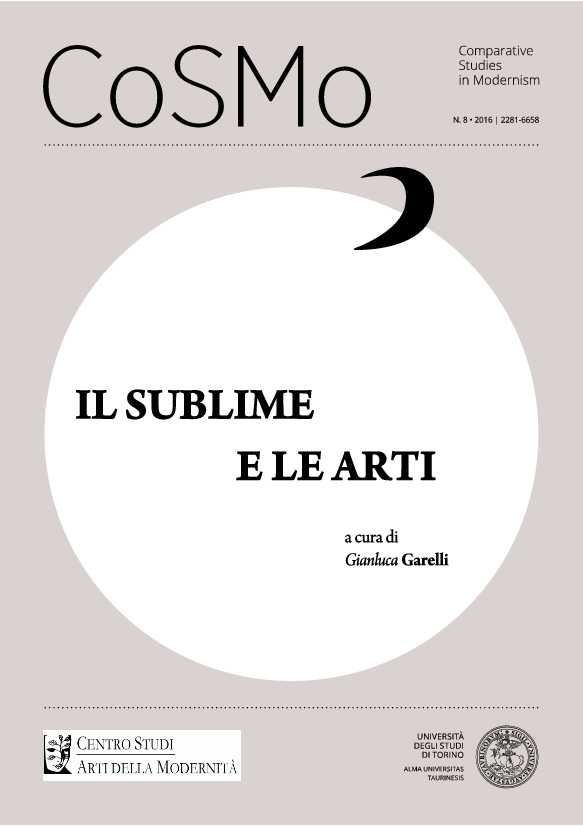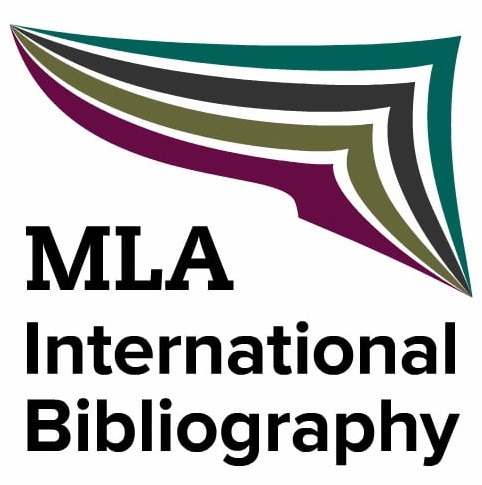Il sublime nell'età delle avanguardie. Ideale e tradizione artistica nella scena americana
DOI:
https://doi.org/10.13135/2281-6658/1372Abstract
In 1964 the American professor Leo Marx published his fundamental essay entitled The machine in the garden : technology and the pastoral ideal in America. Fifty years after its first edition is very interesting return on the relevance of this text, emphasizing on the one hand its obvious value but, on the other, also highlighting its discontinuities.
In this book, Professor Marx dealt with the one of the fundamental issues of American culture: the relationship between landscape, as a central element of literary creation, and the dizzying process of industrial and economic expansion that the United States experienced in the second half of the nineteenth century.
The attention of Marx was entirely turned to literature, analyzing and comparing the works of writers such as Herman Melville and Nathaniel Hawthorne, Ralph Waldo Emerson and Henry David Thoreau , Mark Twain , Frank Norris , Henry Adams , Henry James and Francis Scott Fitzgerald . The thesis of the essay was to underline how the entrance of the industrial landscape in natural American had inevitably destroyed nature, creating a lot of tension and opposition between these two polarities.
He then proceeded to a detailed analysis of how the writers mentioned above had addressed this issue in their works: according to Leo Marx, in the most successful cases these authors, rather than propose a return to a bucolic ideal - necessarily and inherently better only as pre- industrialized - focused on the many contradictions stemming from this paradigm.
This essay aims at analyzing the cultural origins of The machine in the garden, which are rooted in a broader cultural debate that reached its peak between the 1910s and the 1920s. This debate was not limited to writers, but also artists gave their contribution to it: very different personalities, united by a spirit of research of the origins of American culture. Inside - but perhaps it would be more correct to say in parallel – to the avant-garde art and literature that focused its aesthetics on the urban dimension, it developed a spirit of strong resistance to this aggressive modernity which shows strong links with some of the trends Leo Marx identified as characteristic of the nineteenth century. In particular, this essay focuses on the group of artists belonging to the so-called Stieglitz’s circle – formed by the American photographer and some of the painters he supported with his galleries, such as Georgia O’Keeffe, John Marin, and Marsden Hartley – who offered a particular interpretation of the American experience of the sublime, as a distinct element of national identity and as an antecedent to Marx’s position.
Not surprisingly, some artists and writers active in the first decades of the twentieth century started to find those elements of modernity as exclusively urban and industrial not exhaustive of the national experience and moreover also very arbitrary.
A key moment to understand these deep transformations of American culture are the 1910s, a decade which revealed the sense of deep dissatisfaction with urban theme. Curiously, it was mostly the artists and intellectuals who had formed part of the circle of the photographer Alfred Stieglitz (1864-1946) - which in the previous decade had contributed to the iconographic fortune of the American metropolis , - the first to show a growing dissatisfaction with the city.
"Belonging" and " identity " became two key terms of the American cultural debate of that period , in which the circle of the photographer is fully took part. The urgency of those years was all for the identification and definition of the national character of culture, which were traced not only in the experience of the urban metropolis but that, indeed, was increasingly moving away from that subject. The opinions of the circle were undoubtedly influenced by the contemporary cultural debate and by the works of such critics and intellectuals such as Van Wyck Brooks, Randolph Bourne, and Waldo Frank. The work of Leo Marx took shape precisely from the comparison with, and sometimes in direct opposition to those works.
So it was already in the 1910s that the natural element was granted an almost mythical status which was not limited to literature and art, but that implied a broader reconsideration of the national identity and experience. It did not represent an anti-modernist stance, rather it should be considered as a complement of a broader, general reflection on modernity: nature, in fact, reconnected to its sublime meaning, taking an heroic character, synonym of resistance to the alienation introduced by modernity and industrialization.
Downloads
##submission.downloads##
Pubblicato
Fascicolo
Sezione
Licenza
Gli autori mantengono i diritti sulla loro opera e cedono alla rivista il diritto di prima pubblicazione dell'opera, contemporaneamente licenziata sotto una Licenza Creative Commons - Attribuzione che permette ad altri di condividere l'opera indicando la paternità intellettuale e la prima pubblicazione su questa rivista.







